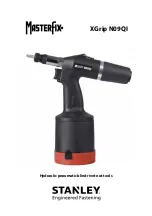
For those of you setting up the TWIN on an “INCRA
TWIN ready” router table, the mounting holes will be
predrilled with T-nuts installed. Skip to Step 2.
Suggested Router Table Dimensions
If you donʼt already own a router table, Fig. 1 gives minimum
dimensions for a table top designed around the TWIN and its
capabilities. If you have a router table top that is not long
enough to handle the full range of the TWIN, see the Tip at
right for an easy way to extend your table dimensions.
Drill Mounting Holes
Begin by drilling the (8) mounting holes in your router
table top. A paper pattern is provided to make locating the
holes easy. Draw a line extending from the center of the
hole in your router table toward the far edge of the table,
Fig. 2. This line needs to be parallel to the edges of the
table so take a few measurements at each end of the line to
make sure it is. Position the dark line on the pattern right on
top of the line you draw. Slide the pattern back until the
marked edge is 22" from the center of the hole in your table.
Tape the pattern in place.
3
Extending your router table length
Screw aluminum or steel angle to underside of
router table to provide support for table extension.
The extension needs to be flush and parallel to the
table top. Shim to alignment as necessary.
Fig. 1
Suggested router
table dimensions
Fig. 2
Drill mounting holes
NOTE
1
TWIN LINEAR SETUP
Extension wing
Wood screws
Aluminum or steel angle
Paper pattern
Drill
1
⁄
4
" holes if you want to use the 10-24 x 1
3
⁄
4
" machine
screws and hex nuts.
Drill
1
⁄
8
" holes if you want to use the 10 x
7
⁄
8
" wood screws.
NOTE
Placing the pattern 22" away from the center of the
hole will allow you the maximum usable range of the
TWIN. Moving the pattern closer to the hole on
smaller tables does not limit the full use of the many
features of the TWIN, it only decreases the distance
that the fence can be moved from the cutter later on.
The base mount hardware pack gives you a couple of
fastener options. You can mount the base with (8) 10 x
7
⁄
8
"
wood screws with washers, in which case youʼll want to
predrill the (8) holes with a
1
⁄
8
" drill bit. Or you can use the
(8) 10-24 x 1
3
⁄
4
" phillips pan head machine screws and
predrill the (8) holes with a
1
⁄
4
" bit. I prefer the machine
screws, but if you choose this option, make sure you have
clearance under the table for the washers and nuts at all eight
mounting hole locations.
Attach Base to Router Table
Slide the carriage out of the base. Depending on which
fastener option you selected in Step 1, attach the TWINʼs base
to your router table. Put a washer on the screw first and make
sure you place a screw in each of the eight slotted holes in the
base, Fig. 3. on the next page. If you are using the machine
screws, place a washer and hex nut on the screw from under
the router table. Tighten all (8) mounting screws.
24"
12"
12"
43"
31"
Existing router
table top
22"
2
FACT
Infeed and Outfeed
Infeed refers to everything that is before the cutter,
while outfeed is everything that is after the cutter. Youʼll
hear about infeed and outfeed fences, of course, but
you also have an infeed and outfeed side to your router
table, and youʼll learn how to set an infeed or outfeed
stop later in this manual. Your INCRA TWIN LINEAR is
the only fence of its kind to offer separate infeed (black)
and outfeed (gold) carriages, each controlling its own
fence. The “twin” carriages can operate in tandem, or
independently for offset fence applications.




































